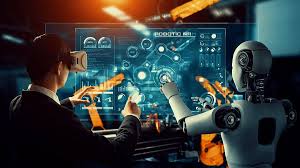Robotics is a multidisciplinary field that combines mechanical engineering, electrical engineering, computer science, and artificial intelligence to design, construct, and operate robots. These programmable machines can perform tasks autonomously or semi-autonomously, often undertaking duties that are dangerous, repetitive, or complex for humans. Applications of robotics span across manufacturing, healthcare, space exploration, military operations, and domestic activities.
 |
| ROBOTICS |
Key Aspects of Robotics
1. Mechanical Design and Engineering
This aspect focuses on the physical structure and movement capabilities of robots. Engineers design components such as the body, arms, wheels, and joints to ensure the robot can perform tasks effectively. Key elements include actuators (motors and mechanisms that enable movement), kinematics and dynamics (the study of motion and forces acting on the robot), and end effectors (tools like grippers or sensors that interact with the environment).
2. Electronics and Electrical Engineering
This area deals with the control systems that power and guide the robot. Electrical components include sensors (devices that help the robot perceive its environment, such as cameras and ultrasonic sensors), microcontrollers and microprocessors (the "brains" of the robot), and power systems (batteries and electrical circuits that provide energy).
3. Computer Science and Software Development
Robotics relies heavily on software to control behavior, decision-making, and learning capabilities. This includes programming (writing code to define how the robot behaves), artificial intelligence (enabling robots to learn, reason, and make decisions), machine learning (allowing robots to adapt to new situations based on data and experiences), and computer vision (teaching robots to interpret and understand visual input from cameras).
4. Control Systems
Control systems allow robots to maintain stability, accuracy, and precision while performing tasks. Key control techniques include feedback loops (ensuring real-time adjustments to maintain accuracy), path planning (calculating how a robot should move from one point to another efficiently), and automation (the ability to perform tasks with minimal human intervention).
5. Human-Robot Interaction (HRI)
This aspect studies how humans and robots interact and collaborate. It focuses on user interfaces (ways for humans to communicate with robots, such as touchscreens and voice commands), safety (ensuring robots operate safely around humans), and ergonomics (designing robots that can easily interact with humans in collaborative environments).
Recent Innovations in Robotics
AI Integration and Autonomous Learning
Artificial intelligence (AI) and machine learning are increasingly becoming integral components of robotic systems. Advanced algorithms enable robots to learn from data, adapt to dynamic environments, and make autonomous decisions. This trend is driving the development of intelligent robots capable of performing complex tasks with greater efficiency and flexibility, from autonomous vehicles to collaborative robots in manufacturing.
Collaborative Robots (Cobots)
Collaborative robots, or cobots, are designed to work alongside humans, enhancing productivity and safety in various industries. These robots are equipped with advanced sensors and AI integration, making them safer and more efficient. Companies like Universal Robots and ABB have introduced models that can handle complex tasks, from welding to surgical assistance.
Soft Robotics
Soft robotics is another area that has seen significant growth. Unlike traditional robots made of rigid materials, soft robots are composed of flexible, soft materials. This makes them ideal for tasks that require gentle interaction, like handling fragile objects or performing medical procedures. Bio-inspired robots, mimicking the movements and structures of living organisms, have been developed to navigate through tight spaces and manipulate objects with flexibility.
Humanoid Robots
Humanoid robots, designed to mimic human movements and interactions, are making significant strides. For instance, Boston Dynamics has unveiled its humanoid robot, Atlas, capable of performing tasks autonomously without human intervention. In a recent demonstration, Atlas handled tasks like moving engine covers and navigating a dolly, simulating factory work, using machine learning for vision and adaptability. This marks a significant advancement, as it is now entirely electric, allowing greater motion range.
Applications of Robotics
Manufacturing
The manufacturing industry has experienced a radical transformation due to robots, enabling faster and more precise production processes. Robots are utilized in assembly lines, material handling, and quality control. The advantages of automation include increased productivity, reduced errors, and enhanced worker safety. Collaborative robots (cobots) work alongside humans, enhancing efficiency and flexibility in manufacturing operations.
Healthcare
In healthcare, robots have brought about remarkable advancements. They play roles in surgical procedures, rehabilitation, and patient care. Surgical robots offer precision and accuracy, leading to improved outcomes and quicker recovery times. Robotic exoskeletons assist patients with mobility impairments, and telepresence robots enable doctors to provide consultations from a distance.
Logistics and Warehousing
The logistics and warehousing sector has embraced automation to optimize operations and meet the demands of e-commerce. Autonomous robots are used for warehouse management, including order picking, inventory tracking, and goods transportation. Drones are employed for last-mile delivery, enhancing speed and efficiency. Automation in supply chain management leads to cost reduction and error minimization.
Space Exploration
Robotics plays a crucial role in space exploration, enabling missions that are too dangerous or impossible for humans. Robotic rovers, like NASA's Perseverance, explore planetary surfaces, collecting data and samples. Robotic arms assist in assembling and maintaining spacecraft and space stations. The development of autonomous robots capable of operating in the harsh conditions of space continues to advance, pushing the boundaries of exploration.






0 Comments